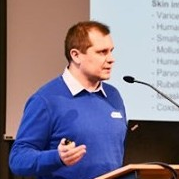DNA Damage Response
A special issue of Biomolecules (ISSN 2218-273X). This special issue belongs to the section "Molecular Biology".
Deadline for manuscript submissions: closed (26 July 2020) | Viewed by 18600
Special Issue Editors
Interests: DNA damage response; DNA repair; DNA damage detection; genotoxic stress; genomic stability; anti-cancer therapy; cell death; apoptosis
Special Issues, Collections and Topics in MDPI journals
2. Department of Biosciences and Nutrition (BioNuT), Karolinska Institutet, 14183 Huddinge, Sweden
3. KG Jebsen Centre for B Cell Malignancies, Institute of Clinical Medicine, University of Oslo, 0316 Oslo, Norway
4. Institute of Clinical Medicine, University of Oslo, 0318 Oslo, Norway
Interests: DNA repair; DNA damage response; genetics; primary immunodeficiency; B lymphocyte development; mouse models
Special Issues, Collections and Topics in MDPI journals
Special Issue Information
Dear Colleagues,
Lesions are generated continuously in our cellular DNA by external and internal factors. The DNA damage response (DDR) detects and repairs the lesions. Failures in DDR results in developmental disorders, innate and adaptive immune responses, cancer, and ageing. We thus invite the submission of original research manuscripts and review articles that cover any aspects of DDR and related topics.
I am looking forward for your contribution.
Dr. Denis KainovDr. Valentyn Oksenych
Guest Editors
Manuscript Submission Information
Manuscripts should be submitted online at www.mdpi.com by registering and logging in to this website. Once you are registered, click here to go to the submission form. Manuscripts can be submitted until the deadline. All submissions that pass pre-check are peer-reviewed. Accepted papers will be published continuously in the journal (as soon as accepted) and will be listed together on the special issue website. Research articles, review articles as well as short communications are invited. For planned papers, a title and short abstract (about 100 words) can be sent to the Editorial Office for announcement on this website.
Submitted manuscripts should not have been published previously, nor be under consideration for publication elsewhere (except conference proceedings papers). All manuscripts are thoroughly refereed through a single-blind peer-review process. A guide for authors and other relevant information for submission of manuscripts is available on the Instructions for Authors page. Biomolecules is an international peer-reviewed open access monthly journal published by MDPI.
Please visit the Instructions for Authors page before submitting a manuscript. The Article Processing Charge (APC) for publication in this open access journal is 2700 CHF (Swiss Francs). Submitted papers should be well formatted and use good English. Authors may use MDPI's English editing service prior to publication or during author revisions.
Keywords
- DNA damage response
- DNA repair
- Cell death
- Genomic instability
- Innate immunity
- Adaptive immunity







